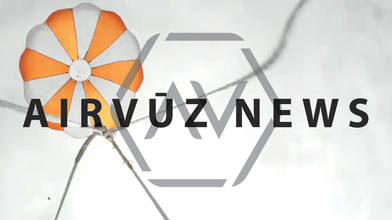
AV News: The Future of Flying Over People
- about 8 years ago
- 1.2k VŪZ
28 
- 19
- Report
Flying over people with a drone is something most drone pilots know not to do. Some companies, however, are doing their part to make it safer to fly over crowds. One of the many hurdles commercial drone pilots face under current Federal Aviation Administration regulations is the inability to fly over people. Because of that guideline, flying drones at large events and gatherings is rather tricky. There have been discussions about how to make flights over people safer, and several companies are hoping their products will be required in the future for those types of operations. ParaZero, Fruity Chutes and Indemnis all displayed their parachute systems at this year’s InterDrone conference in Las Vegas. Each safety system is a bit different in both appearance and function, but all three companies aim to make it safer to fly over crowds — if and when the FAA makes it easier to do so. Under current FAA regulations, drone operators must apply for a waiver to fly over people. Only two companies have been granted those waivers so far. While the safety of people on the ground is important, these parachutes also offer protection for the drone - sometimes, to the tune of tens of thousands of dollars. “Four years ago, we were an entirely different company. We were actually drone services providers for film. And then we crashed an S-1000 with a Red Epic camera. It was one of our largest financial losses, and as we were sitting there looking at the wreckage, we realized we need a safety solution — just in case.” Gene Engelgau started Fruity Chutes in 2007. The company initially made parachutes for high-powered rockets that needed to be retrieved after launching. In recent years, they added parachutes for drones to their offerings. “There’s about 13 different companies, groups that represent different stakeholders in this that are actually trying to work on the draft ruleset of how do you safely fly over people? And parachutes are like one of the central pieces of that. That’s because a parachute takes an energy from 100 percent of the energy hitting you down to maybe 1 to 2 percent of that.” Indemnis, a company from Alaska, also demonstrated its parachute system in the fly cage at InterDrone. The Indemnis system deploys a parachute with a ballistic launcher at a speed of 90 miles per hour. “Right now, we’re one of the only people who can meet the upcoming FAA standards. We’re working hand-in-hand with them. Our CEO is chair of the ASTM committee, which has brought together a bunch of industry leaders to work on these standards and work through first-hand what works, what doesn’t, and kind of set the bar for the waiver process. It still has a lot of traction that it needs to get approvals, but hopefully, fingers crossed, in the next six to eight months we’ll have a process for that.” But not every company is convinced parachutes are the best option. Plimp, presented by brothers Joel and James Egan of Egan Airships, is a 28-foot-long plane-blimp hybrid that they claim is plummet-proof. That means safer flights over people, and they hope that one day the craft will grow in size and safety to accommodate commuters. "When we’re talking about safety of people on the ground and safety of your own equipment so it doesn’t get destroyed, Plimp is the answer. Plimp is an amazing invention. It’s probably the best invention of the 21st century.” Delivery companies, cinematographers, relief missions and more are all examples of clients who have used a variety of recovery systems already, and those making the systems hope the market will keep growing. But regulations must first change so these companies — and the industry — can flourish. VIDEO TRANSCRIPT: Kendall: Flying over crowds of people is a big no-no. It can make it really hard to shoot things like concerts, events, and even small films. Luckily, some companies are doing everything they can to make it safer to fly over crowds. Our Tyler Mason shows us how they're doing it. Tyler: One of the many hurdles commercial drone pilots face under current Federal Aviation Administration regulations is the inability to fly over people. Because of that guideline, flying drones at large events and gatherings is rather tricky. There have been discussions about how to make flights over people safer, and several companies are hoping their products will be required in the future for those types of operations. Parazero, Fruity Chutes, and Indemnis all displayed their parachute systems at this year's Interdrone Conference in Las Vegas. Each safety system is a bit different in both appearance and function, but all three companies aim to make it safer to fly over crowds if and when the FAA makes it easier to do so. [00:00:58] Under current FAA regulations, drone operators must apply for a waiver to fly over people. Only two companies have been granted those waivers so far. While the safety of people on the ground is important, these parachutes also offer protection for the drone, sometimes to the tune of tens of thousands of dollars. Roi: Four years ago, we were an entirely different company. We were actually drone service providers for film and we crashed an Red Epic camera. It was one of our largest financial losses, and as we were sitting there, looking at the wreckage of the drone, we realized we needed a safety solution just in case. Tyler: Gene Engelgau started Fruity Chutes in 2007. The company initially made parachutes for high-powered rockets that needed to be retrieved after launching. In recent years, they added parachutes for drones to their offerings. Gene: There are about 13 different groups that represent different stakeholders in this that are actually trying to work on the draft ruleset of how to safely fly over people. [00:01:59] Parachutes are, like, one of the central pieces of that, and that's because a parachute takes an energy from 100 percent of the energy hitting you down to maybe 1 or 2 percent of that. That's a huge difference. Tyler: Indemnis, a company from Alaska, also demonstrated its parachute system in the fly cage at Interdrone. The Indemnis system deploys a parachute with a ballistic launcher at a speed of 90 miles per hour. Amber: Right now, we're one of the only people who can meet the upcoming FAA standards. We're working hand in hand with them. Our CEO is the chair of the ASTM Committee, which has brought together a bunch of industry leaders to work on these standards and work firsthand through what works, what doesn't, and set the bar for their waiver process. It still needs to get a lot of traction and approvals, but hopefully - fingers crossed - in the next six to eight months, we'll have a process for that. [00:02:56] Tyler: But, not every company is convinced parachutes are the best option. Plimp, presented by brothers Joel and James Egan of Egan Airships, is a 28' plane/blimp hybrid that they claim is plummet-proof. That means safer flights over people, and they hope that one day, the craft will grow in size and safety to accommodate commuters. Joel: When we're talking about safety of people on the ground and safety of your own equipment so it doesn't get destroyed, Plimp is the answer. Plimp is an amazing invention. It's probably the best invention of the 21st century so far. Tyler: Delivery companies, cinematographers, relief missions, and more are all examples of clients who have used a variety of recovery systems already, and those making the systems hope the market will keep growing. But, regulations must first change so that these companies and the industry can flourish. At AirVūz News, I'm Tyler Mason. [End of Audio] Duration: 4 minutes
Up Next
FPV Pilots to Watch - 11/28/25

- AirVuzFPV
- 22 VŪZ
0 - 0
- about 10 hours ago
Drone Video of the Month, November (2025)

- Drone Video Contests
- 396 VŪZ
1 - 1
- 2 days ago
Drone Video of the Week, Episode 47 (2025)

- Drone Video Contests
- 251 VŪZ
1 - 0
- 4 days ago
FPV Pilots to Watch - 11/21/25

- AirVuzFPV
- 281 VŪZ
0 - 0
- 7 days ago
Announcing: AirVuz 2025 Drone Video of the Year Contest

- AirVūz Official
- 339 VŪZ
7 - 4
- 9 days ago
Drone Video of the Week, Episode 46 (2025)

- Drone Video Contests
- 649 VŪZ
1 - 1
- 11 days ago
FPV Pilots to Watch - 11/14/25

- AirVuzFPV
- 403 VŪZ
0 - 0
- 18 days ago
Drone Video of the Week, Episode 45 (2025)

- Drone Video Contests
- 901 VŪZ
1 - 0
- 18 days ago
FPV Pilots to Watch - 11/07/25

- AirVuzFPV
- 287 VŪZ
0 - 0
- 22 days ago
Drone Video of the Week, Episode 44 (2025)

- Drone Video Contests
- 749 VŪZ
1 - 1
- 25 days ago




